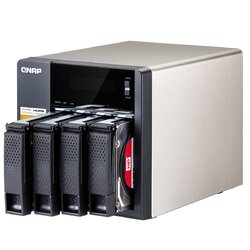This is precisely the same questions I've been mulling over for a few years now. I could really use a NAS like solution but instead have been sharing data from my main machine and running backups of the data drive weekly.
The downfall of buying a NAS device with say Raid5 (3 or more drives in parity/redundancy, striping) is if the unit fails, you're possibly SOL. The controller has to be able to pickup where the prior device left off, and that's assuming you want to replace with the same model that just died on you. Ideally you would have a NAS with two drives, running Raid1 (redundancy only), and in the case of unit death you can still, most of the time, toss the drive into any computer with a USB adapter to access the data. But if you need to store a lot of data you will be limited in Raid1 to the drive sizes the unit supports and largest single drives available on the market. Raid5 definitely allows you room to grow down the road, and you can swap any dead drives while still accessing the data [which is why this configuration is popular with small businesses that have local servers].
Building your own means, in part, that anything that's buggy or fails is your responsibility. It also means time configuring, learning the software you're using, etc. I'm also not sure how much cheaper it will end up being, definitely not if you consider the time involved. The benefit is that you will be able to swap hardware rather easily since it's standard PC components that would fail.
Performance wise I would expect the means of accessing the data (USB, Ethernet) to be the larger limiting factor, and that both solutions if configured and operating properly would offer home users the same experience.
I have to say, I am reading, but not fully following your talk here.
I have a Netgear 4 bay, Running 4x 1Tb drives, to start with i had 4x Seagate drives, then two drives started to act up, so i replaced them with WD drives, and all is fine, no data lost, hot swap was great.
That said, I have had to use support a few times, and Netgear has a 24/7 service, that has been just great. I use my NAS to storing my documents and movies and similar, like OP needs. I have not ever felt limited i have to say, only by maybe not having all media share options. But as a basic run of the mill nas, thinking about it, i could make a better performance NAS unit yes, for the same money, but it would also mean having to put in a whole lot more time getting it working, and then also keeping track of it, where the netgear does all that for me.
If storing and/or sharing data are your only objectives, I think's best to stick with the store bought NAS units, albeit, one with the right set of features for your needs, because they vary greatly in capability. I was in this camp for a long time. I've been able to get by with simple, 2 drive RAID NAS appliances, for backups and file sharing, for the last five years.
For people who like to tinker, learn or have the requisite knowledge to do a custom setup, and have special objectives, home brew is the way to go. But it's not for the faint of heart. Even using software like FreeNAS still requires beyond a very basic level of skill with PC and networking issues.
I see this as the only real reason, for the applications that OP is looking for, buying a solid brand NAS would be the best options, but OP wants to build, and i fully get that, but i also feel that OP is going overboard on the build for what it needs to do, and space taken up will also be larger than may be needed.
I see LinusTech bulding HUGE SSD Nas servers to cope with the data, 4k video and such, i fully understand a custom build here, but as a home network serving as backup, and movie library i would put more time and money into my main rig.

